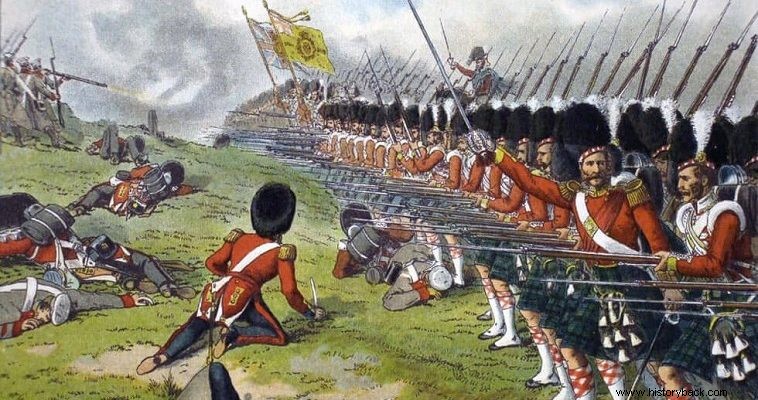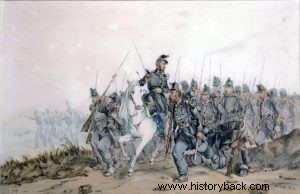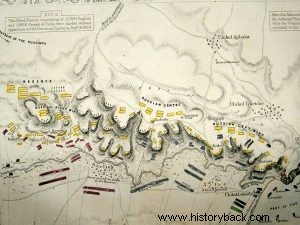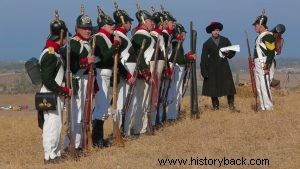
The great conflict known to history as the Crimean War had deep political causes, chief among them, Russia's deepest desire to break up the crumbling Ottoman Empire. Against it, however, Russia found Britain and France, which, for their own reasons, did not wish for the definitive death of the "great patient", as the collapsing Ottoman Empire was characterized at the time.
The declaration of war found the British without a clear objective as to the benefit of the war engagement in which they were engaged. On the contrary, Napoleon III of France had broader aspirations. In principle, of course, he had succeeded in breaking the Austria-Russia alliance.
In the second year, always seeking to weaken Austria, primarily and Russia, secondarily, he believed that he could "resurrect" the triple Russian, Austrian and Prussian occupation of Poland, compensating the Prussians with other territories.
At the tactical level Britain and France also had no idea where and how they would fight against the Russians. The main field of engagement of their forces was finally chosen to be the wider Black Sea region, for the simple reason that if they did not reinforce the Turks, the latter would certainly suffer a severe defeat from the Russians.
At the same time, however, the British sent their forces to the Baltic Sea and the Pacific, with the Crimean War eventually developing into a small global conflict.
In the meantime, the Russians, after the declaration of war, advanced as far as Bucharest, undisturbed. Only after the capture of this city, the Turks reacted and began to gather forces on the Danube.
Following these developments, the Franco-British forces began to gather in Varna, Bulgaria. 60,000 Turks, 30,000 French and 20,000 British gathered in Varna. But there, due to the poor sanitary conditions, they were affected by a cholera epidemic.
The epidemic put at least 5,000 French and 850 British soldiers out of action. Another accident followed when a fire broke out in the city on August 10, 1854, by drunken French soldiers. Nevertheless, the French administration accused five Greek residents of the city, whom the French executed with bayonets, as being responsible for the fire.
Following these developments, it was decided to transfer the expeditionary force to the Crimea and capture Sevastopol. Finally, on September 14, 1854, the allied divisions began to land at a distance of 16 km. south of Evpatoria. The city surrendered without a fight.
On September 19, the allied troops moved towards Sevastopol. After a short march they found themselves on the banks of the small Bulganak river, the first of the four that cross the field from Yevpatoria to Sevastopol.
The fort site of the river Alma
The Russians did not expect an allied landing in the Crimea and that is why they had not reinforced their forces there, which were under Prince Medchikov. But when the Allied landing finally took place, Medchikov, gathered his forces, but did not venture an attack against the Allied bridgehead. If he had done so, the course of history might have been different , as he would have taken full advantage of the confusion prevailing in the allied camp.
Finally Medchikov decided to deploy his forces in the naturally fortified position on the Alma River, north of Sevastopol. There the Christians would clash for the sake of the Turks. Medchikov did not randomly choose the south bank of the small river Alma to defend against the enemy plot against Sevastopol. Immediately south of the river the ground rises into a series of hills, from which access from Yevpatoria to Sevastopol is completely controlled.
The hills extended from the coastline of the Euxinos to a distance of about 13 km, inland, cutting perpendicularly across the field, before their southern bank of the river. Also, on the north bank, there were extensive marshes, which allowed the movement of only four points, three channels of the river and the bridge near the village of Burliuk, through which also passed the public road that connected Yevpatoria with Sevastopol.
To the right of the road was the Kurgan hill, which dominated it. There Medchikov ordered the construction of fortifications. Further west was Telegraph Hill, as the British called it, because of the optical telegraph facilities on it, which extended to the sea.
On the north bank of the river there were, from west to east, the villages of Alma Tamak, Burliuk and Tarkanlar. On the south bank, towards the sea, there were the small villages of Akles, at a distance of 400m. from the coast, Horta Kisek and Anji Bulat. All the villages in the region were inhabited by Muslim Tatars, who considered the Turks liberators.
On this site Medchikov ordered his approximately 34,000 men. Medchikov had at his disposal the 6th Army Corps, under General Prince Gorsakov, and part of the 5th SS, under Lieutenant General Kiryakov.
On the opposite side were the British Army, under Marshal Baron Raglan, with 27,000 men and 60 guns, the French Army of the East, under Marshal Saint Arnault, (28,000 men with 68 guns) and the Turkish Division (Suleiman Pasha) with three SPs, with a total strength of approximately 7,000 men. In total the allies contributed 61,000 men and 128 guns.
Blood in the river
On the evening of September 19, 1854, the allies camped between the south bank of the Bulganak River and the north of the Alma River, in a particularly exposed location, considering the small number of horsemen they had.
Had Medchikov been a more energetic general, he might have taken advantage of his superiority in cavalry and carried out an operation against the allied camp. He could still make use of his Cossacks, unleashing them in attacks against the overextended and almost unbroken Allied line of transport from Yevpatoria. He did none of these, contenting himself with a passive defense.
On the evening of September 19 Lord Raglan called a council of war in a hut near the bridge near the village of Burliuk. Raglan and Saint Arnaud came up with the plan of attack, which called for a French attack on the Russian left on the sea side and a British attack on the Russian right on Kurgan Hill.
This plan was inspired by the French marshal, which his British counterpart promised to follow. In fact the two allied commanders had no idea of either the strength of the location or the numerical strength of their opponent, as they had not taken care to order a reconnaissance of the Russian location.
Shortly after 05:30 on the morning of September 20, the French and Turks were ready to launch the attack against the Russian left flank. But the British hadn't even woken up yet. Finally, after quietly getting ready and having breakfast, the British declared themselves ready to attack at 10:30 in the morning, i.e. five whole hours after the scheduled time of the attack.
Finally the advance of the allied forces finally began, to the sounds of military music! However, the lack of cooperation between the British and the French was immediately demonstrated, who, supposedly following the plan to the letter, marched one to the left and the other to the right, leaving a large gap in their center. Terrified, Saint Arnaud and Raglan halted the movement of their units and reorganized their line, losing another hour.
But as it was already noon they decided to stop where the men were for lunch, at a distance of about 2.5 km from the Russian lines. Saint Arnaud then met with Raglan and together they looked towards the Russian lines, with their telescopes, finding, just then, that the Russians held strong defensive positions.
From the coast to Telegraph Hill the Russians had lined up about 12 infantry battalions, supported by 20 guns, of Lieutenant General Kiryakov's 17th MP. Platforms had even been placed on the hill, from where wealthy residents of Sebastopol would watch the battle!
On their right, between the village of Burliuk and Kurgan hill, 18 Russian battalions, supported by 70 guns, were positioned. Four infantry battalions and 14 heavy guns were stationed in two fortifications that had been created, on the slopes of the hill.
Another artillery and five infantry battalions were deployed along the Yevpatoria-Sevastopol road, between Telegraph Hill and Kurgan Hill, under Prince Gorsakov. Medchikov kept seven other battalions and two artillery divisions in reserve.
However, the Russian prince and general Alexander Medchikov should not be pleased. Although he had time, he had not taken care, beyond the two forts on Kurgan Hill, to fortify his site, which presented a great weakness at its extreme left.
Medchikov, fearing an attack by the allied ships, had withdrawn his forces to a distance of 3 km from the sea, as a result of which there was a gap between the Russian positions at the western foothills of the Telegraph Point and the sea, a gap through which, easily could penetrate the enemy behind the Russian left.
Medchikov, never before, had taken part in battle and at the same time had never seen the deadly results of the shots of the new rifled rifles that his opponents possessed. Also the Russian commander was not aware of the lack of training of his men and of course he did not use his cavalry at all, which was outnumbered almost 4:1 by the opponent.
On the other hand, the two allied commanders, after examining the enemy location, came up with their battle plan, inspired by Saint Arnaud. Based on this, two French divisions would exploit the gap in the Russian line near the sea and attack the Russian left flank. The British would support the attack, pinning down the remaining Russian forces. This plan was good and capable of giving victory to the allies.
De Raglan promised to follow it. Immediately after the meeting with his French counterpart, however, the one-armed British marshal decided that the super waxing maneuver planned by Saint Arnaud had no chance of success. Only a frontal attack, according to Raglan, would bring victory.
Ignoring Raglan's thoughts, Saint Arnaud ordered his forces to move, based on the agreed upon plan. In the first echelon, the 2nd French MP, of Bosquet, rushed out, followed by the 1st of General Canrobert and the Turks. This powerful group of three, essentially, divisions, could prevail against the Russians, at this point, without even needing a British attack.
The 2nd French MP moved with the vanguard of the elite 3rd Hunter Regiment and the experienced 3rd Zouave Regiment and the Algerian Hunter Regiment, in a strafing formation. The other three regiments of the division followed, in battle phalanx formation.
Bousquet divided his forces, finally, and sent his reserve regiments, together with the divisional artillery, to cross the river at a ford above the village of Alma Tamak, so as not to create a congestion.
The Russians did not even notice the French who crossed the Alma River from a channel near the coast and began to climb the western slope of Telegraph Hill. Only when they climbed a small peak were they noticed and the Russian sector artillery turned its guns on them.
In the meantime, however, the French had occupied the western part of the hill and Saint Arnaud was sending his 2nd and 3rd MP to reinforce his vanguard. Carnobert's 1st MP, which was following Bousquet's 1st, crossed the river with ease, behind Bousquet's men, and Prince Napoleon's 3rd MP crossed the river at a ford, west of the village of Burliuk.
The Russians tried to fight back, but the French's modern Minie rifles were hitting them at ranges their own old muskets couldn't answer . The French snipers, with accurate fire, also neutralized the Russian gunners, killing and wounding some and putting the rest to flight, without even getting close to them.
Soon the 1st French MP were also on the western crest of Telegraph Hill, its right covered by the 2nd MP, with the 3rd MP following to cover it on the left. The battle was already lost for the Russians. But Raglan almost gave them the victory.
Medchikov realized rather late that his left side was collapsing. And then, however, he did not order a massive counterattack against the French, but limited himself to reinforcing his left wing with all his reserves. he himself was eventually put in charge of eight battalions and marched against the French, leaving his army without a commander.
At least the Russian reinforcements managed to stop the advance of the 3rd French MP, which was also the least powerful. Saint Arnaud decided to personally command the 3rd MP, but Russian fire forced him to take refuge in a hut near the river, where he was trapped.
Thus, of the three commanders, only Raglan was able to command his entire force. Raglan had decided to attack, as reported. For this purpose he ordered the Light Division and the 2nd MP to deploy from a marching phalanx in line, under enemy fire. This complex maneuver caused confusion among the British infantry, with the result that the battle lines of the two divisions were not deployed parallel, as they should have been.
The 7th Regiment of Royal Fusiliers of the Light Division found themselves behind the 95th Infantry of the 2nd MP, instead of to its side. Bad – bad the two British divisions deployed in two lines each, with about 2,500-3,000 men per line and prepared to attack. But when they reached a distance of 1,500m. from the Russian lines Raglan ordered them to stop.
What had happened? Raglan saw the French had penetrated the Russian position and decided to call off the attack. However, he did not order his two divisions to retreat, slightly, so as not to receive the distant fire of the Russian artillery, nor did he deploy his 1st and 3rd MPs, which were following the first two, in battle formation, leaving them in a marching phalanx formation.
The time had already reached 15.00, the battle had been going on for two hours and the British had not yet crossed the river, only remaining under the fire of the Russian artillery. Five minutes later Raglan ordered an attack, but without specifying the objectives of this attack.
The attack began, without the British forces having reorganized their lines, with the regiments overlapping. The British crossed the river by the bridge, east of the village of Burliuk, but also passing through the rivers, although the water was up to their chests, receiving deadly fire.
The British infantry reformed their lines and took cover at the eastern foot of Telegraph Hill. Some units were ordered to form squares, as there was widespread fear of Russian cavalry. Fortunately for the British, at the foot of the hill the Russian artillery could not easily hit them. Otherwise a massacre would have followed.
With great difficulty the British officers managed to reorganize their divisions, which had become mixed up during the crossing of the river. Finally the Light Division, reorganized first and facing east, marched against the Russian fortifications on Kurgan Hill. The British found opposite them two Russian battalions, deployed in battle phalanx and artillery.
The Russian infantry, in this formation, could not make the most of their limited firepower anyway, and the artillery fire was lethal, but the speed of the Russian guns was limited. Thus the British managed to get within shooting distance. From there they now had the say with their modern rifles with deadly results for the Russians. Soon the British artillery entered the battle.
“The fire of the English rifles and artillery is so dense that our commander is constantly moving to escape them. Στο μεταξύ πολλοί στρατιώτες έχουν τρομοκρατηθεί και γονατισμένοι, συγκεντρώνονται σε ομάδες και προσεύχονται.
“Οι καρδιές μας χτυπούν δυνατά στη θέα της ατελείωτης μάζας των Βρετανών που έρχονται καταπάνω μας, το χωριό Μπουρλιούκ καίγεται και ο καπνός μας τυφλώνει. Καθώς ο εχθρός πλησιάζει τα πυροβόλα μας ανοίγουν μεγάλα κενά στις γραμμές τους. Τα κενά όμως αμέσως κλείνουν και οι αντίπαλοι, αγνοώντας τις απώλειες, συνεχίζουν να έρχονται καταπάνω μας.
“Σε λίγο νιώθουμε τα τρομακτικά αποτελέσματα από τα πυρά των τυφεκίων τους, ξανά. Κάθε βολίδα τους βρίσκει στόχο. Οι αξιωματικοί μας θερίστηκαν. Το πυροβολικό μας πολεμούσε καλά, μέχρι που εξαντλήθηκαν τα πυρομαχικά του», αναφέρει Ρώσος στρατιώτης, περιγράφοντας τη βρετανική επίθεση.
Υπό αυτές τις συνθήκες, στις 15.30, οι Βρετανοί είχαν καταλάβει τις ρωσικές θέσεις στους πρόποδες του λόφου Κούργκαν. Τότε ο αντιστράτηγος Κβετζίνσκι διέταξε το 31ο ΣΠ του να επιτεθεί. Οι Ρώσοι σχημάτισαν τέσσερις φάλαγγες εφόδου και εφόρμησαν με προτεταμένες τις ξιφολόγχες.
Στη βρετανική πλευρά, για άγνωστο λόγο, επικράτησε σύγχυση και τα τμήματα υποχώρησαν προς τον ποταμό, χωρίς στην πραγματικότητα να πιεστούν από τους Ρώσους. Από τη σύγχυση επηρεάστηκαν και τμήματα της 1ης Βρετανικής ΜΠ, τα οποία είχαν μόλις περάσει τον ποταμό και βρισκόταν στη νότια όχθη.
Έτσι, μέχρι τις 15.45, ότι είχαν κερδίσει οι Βρετανοί, με πολύ αίμα, είχε χαθεί. Στο μεταξύ οι Γάλλοι είχαν κατορθώσει να ανεβάσουν τα πυροβόλα τους στη δυτική κορυφή του λόφου του Τηλέγραφου, από όπου άνοιξαν φονικό πυρ κατά των Ρωσικών δυνάμεων, απέναντί τους. Το ρωσικό πεζικό δεν άντεξε και άρχισε να υποχωρεί . Την υποχώρησή του εκμεταλλεύτηκε το γαλλικό πεζικό, το οποίο και κατέλαβε την κύρια κορυφή του λόφου του Τηλέγραφου.
Είχε πλέον καταρρεύσει και το ρωσικό κέντρο και η μάχη είχε οριστικά κερδηθεί για τους συμμάχους. Παρόλα αυτά, καθώς δεν υπήρχε καμία επαφή μεταξύ Σαιντ Αρνώ και Ράγκλαν, ο Βρετανός αρχιστράτηγος διέταξε νέα επίθεση κατά του λόφου Κούργκαν. Αυτή τη φορά στην εμπροσθοφυλακή τάχθηκαν τα σκωτικά συντάγματα της 1ης Βρετανικής ΜΠ, το 42ο Black Watch και το 93ο Sutherland Highlanders.
H βρετανική επίθεση πέτυχε να αποσπάσει από τους Ρώσους τα οχυρώματα επί του λόφου Κούργκαν, κυρίως λόγω της πίεσης των Γάλλων, οι οποίοι, έχοντας συντρίψει το ρωσικό κέντρο, απειλούσαν με περικύκλωση το ρωσικό δεξιό πλευρό.
Ο Μέντσικοφ, ο οποίος δεν είχε πλέον την παραμικρή συμμετοχή στη διεύθυνση της μάχης , δεν είχε πλέον, άλλη επιλογή, από το να διατάξει, γενική υποχώρηση προς τη Σεβαστούπολη. Η πρώτη μάχη του Κριμαϊκού Πολέμου, στην Κριμαία, είχε λήξει με ήττα των ρωσικών δυνάμεων. Ο Ράγκλαν, φοβούμενος, όχι άδικα, την επέμβαση του ρωσικού ιππικού, δεν επέτρεψε στην Ελαφρά Ταξιαρχία να καταδιώξει τους ηττημένους Ρώσους.
Losses were heavy. Οι Ρώσοι είχαν 1.800 νεκρούς και 3.900 τραυματίες. Οι Βρετανοί θρήνησαν 362 νεκρούς, αλλά είχαν και περισσότερους από 2.500 τραυματίες. Οι Γάλλοι είχαν τις μικρότερες απώλειες, έχοντας 200 νεκρούς και 1.200 τραυματίες. Οι μεγάλες ρωσικές απώλειες ήταν αποτέλεσμα, κατά κύριο λόγω, των πυρών των τυφεκίων ραβδωτής κάννης των συμμάχων, ενώ οι συμμαχικές απώλειες οφείλονται κατά κύριο λόγο στο ρωσικό πυροβολικό.

Γάλλοι στρατιώτες στη μάχη του ποταμού΄Άλμα.


Αναβιωτές με ρωσικές στολές της εποχής.
